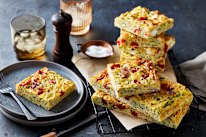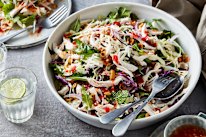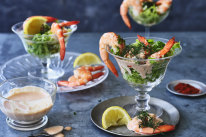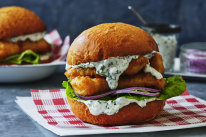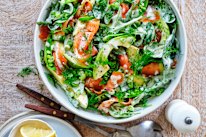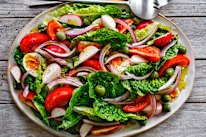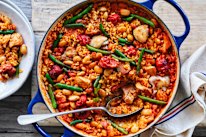Adam Liaw’s shepherd’s pie masterclass (plus a genius tip for browning the meat)

Shepherd’s pie was one of my favourite childhood dishes. With a couple of easy but clever tricks, you can turn a good dish into a great one.
Ingredients
2 tbsp vegetable oil
1kg lamb mince
1 large onion, finely diced
2 carrots, finely diced
1 celery stalk, finely diced
2 garlic cloves, roughly chopped
1 tsp salt
2 tbsp tomato paste
1 stalk rosemary, leaves stripped and finely chopped
3 sprigs thyme, leaves stripped
½ cup plain flour
½ cup red wine
1 litre beef stock
1 tbsp worcestershire sauce
1 tbsp dark soy sauce
2 cups frozen peas
MASHED POTATOES
1.5kg potatoes
150ml milk
100g butter
salt to taste
Method
Step 1
Heat a large casserole dish over medium heat and add the vegetable oil. Roughly form the mince into a large puck and fry it as you would a giant hamburger (see tips). When the “hamburger” is well browned on one side, flip it over and add the onion, carrot, celery, garlic and salt to the pan and fry for about 10 minutes, until fragrant and softened. Use a wooden spoon to break up the browned mince patty into the vegetable mixture.
Step 2
Add the tomato paste and chopped herbs, stir well, then add the flour and stir for about 3 minutes to combine with the mince and vegetables. Add the wine and bring to a simmer. Simmer for 2 minutes, then add the stock, worcestershire sauce and dark soy and simmer, covered for 1 hour.
Step 3
Uncover and continue to simmer for about 30 minutes, until the mixture is thick. Remove from the heat and stir the peas into the warm mixture. Transfer the mixture to a large baking dish, allow to stand and cool while you make the mash.
Step 4
Heat the oven to 200C fan-forced (220C conventional).
Step 5
To make the mashed potatoes, peel the potatoes and cut them into large chunks. Place in a large saucepan and cover with cold water. Bring to a simmer and simmer for 15-20 minutes until the potatoes are very tender. Test them by inserting a sharp knife into a piece of potato. It should enter and exit easily. Drain the potatoes well and return them to the warm pot over very low heat for about 3 minutes to steam off some of the residual moisture.
Step 6
Mash well, then add the milk and butter and mix vigorously with a wooden spoon to produce a smooth mash. Season well with salt and spread the mash over the filling in the baking dish. Rake a fork across the top to create texture. Bake for 25 minutes until the mash is golden brown.
Masterclass
What is shepherd’s pie?
There is an awful lot of discussion around what is shepherd’s pie, and more particularly what it is not. The purists assert that shepherd’s pie can only be made from leftover roast lamb chopped finely and mixed through a thick gravy before being topped with potato and baked. But the purists can think whatever they like because frankly, if I’m cooking enough roast lamb to have enough left over to make a whole pie, I’m definitely doing something wrong.
Other than that more extreme view, the consensus is that a potato-topped pie made with lamb is a shepherd’s pie, and one made with beef or other meat is a cottage pie. For its part, the potatoes should be mashed and not sliced lest the pie be confused with its cousin, the Lancashire hotpot.
Why a giant hamburger?
Browning the meat in a big patty shape helps you to get more colour on the mince. In previous columns we’ve talked about Maillard reactions and how getting meat brown increases its savoury, umami taste. These reactions happen quickly at high heat so when browning meat, the main thing you should consider is how to get the meat brown before it releases its liquid. When meat is cooked, its muscle fibres tighten, squeezing out some of the meat’s juices. Without getting too technical, a water-based liquid in a pan (such as meat juices) will reduce the heat of the pan due to the latent heat of vaporisation. Essentially, the water requires additional energy to change state from liquid to gas, so in order to evaporate, the water will draw energy from the pan, cooling it down and stopping your meat from browning.
It should go without saying that mince is tiny pieces of meat, so if you crumble a large amount of mince into a pan, it will release its liquid quickly and won’t brown. By forming the mince into a giant patty, however, the meat in contact with the pan will brown before releasing too much liquid. Not every bit of mince needs to be browned, but just browning the outside of the patty will significantly increase the flavour of your pie. Of course, you’ll need to break up the patty as you start to add other ingredients so you don’t end up with a big lump of mince in your pie. This tip was passed to me by chef and fellow Good Food contributor Danielle Alvarez and it’s an absolute keeper.
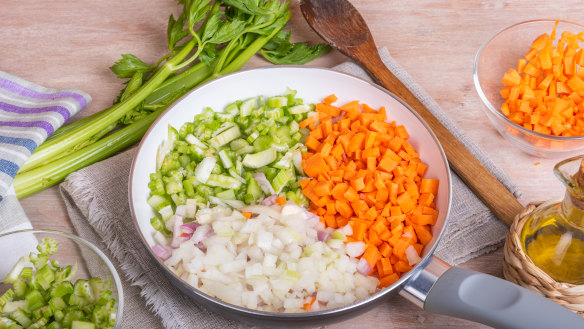
Vegetables?
Adding vegetables to your shepherd’s pie is optional. I’d certainly keep the onion, carrots and celery used as a mirepoix for the base of the filling, but I also like to add peas. You could, of course, leave the peas out of the filling and serve them separately, or you could go the other way and load even more vegetables into the pie filling itself.
Mashed potato
There are many ways to make mashed potato, and your choice of method is mainly an exercise in working out how much labour you’re willing to apply to increase the quality of your mash.
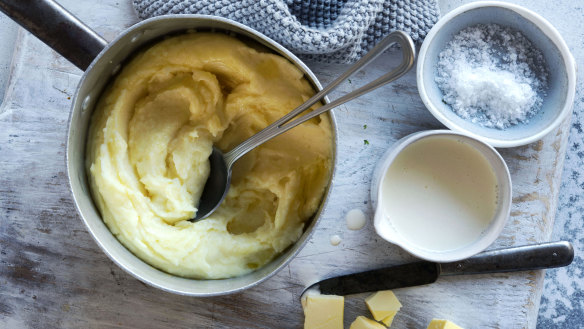
At one end of the spectrum is the belt and braces approach where you roast potatoes whole on a bed of salt, pass them through a potato ricer while still hot, and then beat in a good amount of butter, cream and/or milk. This will produce a gold-standard mash, as the potatoes don’t absorb much water through being baked, so your mash will not be gluey. Using the ricer also means that your mash won’t be lumpy. The drawback to this method is that it takes a lot of time and effort. You’ll need a ricer, the potatoes will take nearly 90 minutes to roast and working with them while still hot means the risk of burnt fingers.
At the other end of the spectrum is the mashed potato most of us grew up with. Boiled chunks of potato, pulped with a masher and mixed with butter and milk. I think this method is entirely fine for a shepherd’s pie, but I take a few extra measures to improve its quality.
I cut my potatoes in large chunks to make sure they don’t absorb too much water. I start them in cold water and boil them for long enough so that they are entirely softened. Undercooking potatoes, or starting them in hot water, is usually what makes a mash lumpy. Starting potatoes in hot water can swell the starch globules around the surface of the potato, which makes it harder for the heat to penetrate to the centre. Returning the potatoes to the hot pan to dry over low heat for a while drives off yet more moisture to avoid a gluey mash.
Appears in these collections
- Freeze-friendly feasts: These recipes are your secret weapon for easy weeknight meals
- Adam Liaw’s masterclass is in session: Five comforting winter classics every cook should know
- 14 of Adam Liaw’s best ever winter recipes to cook this week
- 20 of last winter’s most-loved recipes to cook again this one
- Oldies but goodies: 10 of your favourite childhood recipes to cook next week
The best recipes from Australia's leading chefs straight to your inbox.
Sign upMore:

